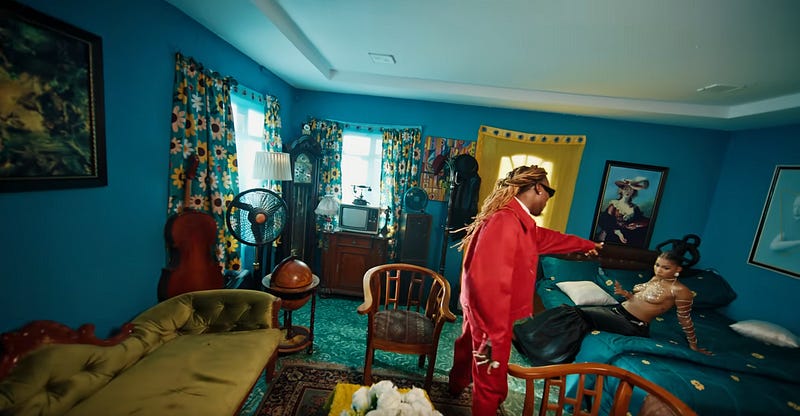Àsàkẹ́: The Lyrics, The Culture, The Renaissance and Yorùbá.
A quick listen to Àsàkẹ́’s music will captivate you and transport you to the climax of entertainment from the beginning to the end of each…
A quick listen to Àsàkẹ́’s music will captivate you and transport you to the climax of entertainment from the beginning to the end of each track. While his music is a fusion of Afro beat, Fuji music, Rap and pop culture, the epitome of Àsàkẹ́’s melody is deeply rooted in the enigma of his lyrics. His ability to wound complex messages into a 3 minutes track is not easily deciphered by the novice.
Perhaps Àsàkẹ́’s Organize track is one of the best visual albums of recent. While the track is a pop culture darling, very few will agree that the album was actually narrating the story of the fall of a great empire of Ọ̀yọ́ (1500–1837) while also showcasing the beauty of the Yorùbá culture, its uniqueness, and versatility to the world and to creativity.
The effortless superimposition of the theme of “o gbọ́n gbọ́n jù, O gbọ́n, à gbọ́n gbọ́n jù ọgbọ́n”with a tribal marked masked thief who was selling an ancient art piece to a foreign dealer appeared benign, but it’s actually Communicating a great theme. The continued trading of priceless pieces of ancient works of art and customs continued to hunt modern Africa.
In addition, Àsàkẹ́ incorporated the intelligentsia ability of the Yoruba “Ọgbọ́n” with the flaws of how some members of the Ethnic group are trading their priceless inheritance for few dollars. His use of the alliteration “o gbọ́n gbọ́n … gbọ́n gbọ́n” exemplified the versatility of the Yorùbá language in being a rhythmic love language that transcends the native speaker of the language.
While the Yorùbá language is captivating the listener of the track, the deeper meaning of the phrase and its visual component is communicating how excessive intelligence may eventually be the detriment of an over confident genius.
Although the depicted Ọ̀yọ́ man was smart enough to smuggle an ancient heritage piece out of its domain, his smartness was inadequate to protect him from the repercussions of his actions as he ended up in the dungeon, after a multiple of similar looking men who matched his intelligence were able to put him to trial. The dungeon is the ancient prison of the Yorùbá called Túbú.
Likewise, the group of wise men that convicted one of their kind were a representation of the ancient Ọ̀yọ́ Ìwàrẹ̀fà which were known as the cult of wise 6–8 wise men that has the authority of putting the checks and balances in place for the Yorùbá kingdom of ancient.
The narrow hallway with an assembly of men who seemingly were dressed in Fulanisque attire suggested the aftermath of the fall of Ọ̀yọ́ Empire, the many battles of the Yorùbá with Fulani and the dark sea voyage of the middle passage. The few second depictions lead us to the emergence beyond the sea of a fully matured descendant of Odùduwà fully dressed in a full red garb reminiscent of the color of Alaafin Sàngó of the ancient Òyọ́ empire.
Color mixtures usage of the music video of Organize paid a great homage to Yorùbá ancestors beyond Beyoncé’s Lemonade. Àsàkẹ́ dressing fully in Aláàfin Sàngó’s red colored outfit matched with Aláàfin Sàngó’s signature hair braid is an homage to the Yorùbá ancient king.
The brightly colored golden yellow drape on the window of his room is an undeniable homage to the Goddess Ọ̀sun while he was literally in the company of a seductress woman characteristic of the Goddess.
The color blue is universally known as the color of the ocean. The artist’s use of a blue room symbolizes the Yorùbá Goddess Yemọja and the over-representation of the Yorùbá youths in the newer exodus of African youths’ voluntary emigration from the Africa continent.
The goddess of the ocean Yemọja is also significant in the transportation of many Africans to the new world via the transatlantic route. The picture of a Caucasian woman on the wall of the blue room signifies the new reality of the descendants of Odùduwà in a foreign land.
The color black was strikingly worn by the love interest of Àsàkẹ́, this woman is also very mysterious. She combined the aesthetics of an African woman clad in gold and the divine color black with that of foreign cultures, perhaps to further depict her mixed heritage and the newer identity of the Africans who were transported via the middle passage.
The color black on her is not very apparent, but she was paying homage to Ẹlẹ́gúāá whose bust was sitting quietly next to her in his typical association with women and temptations. The color black is also one of the nine colors of Ọya who was known as the warrior queen of Sango.
To contrast Àsàkẹ́’s red to the stark black skirt of his seductress is a subtle homage to the great love story of Ọya and Sàngó and the tumultuous relationship that they had.
The green-eyed baby is undeniably a promise of the future generations of the Àrẹ̀mọ Aláàfin. These children are unique and promised to be…
There is no doubt that Àsàkẹ́ is no ordinary man. He is a reincarnated ancestor here for a purpose, to remind us of who we were and wake us up to our greatness as Yorùbá. The world can’t wait.










